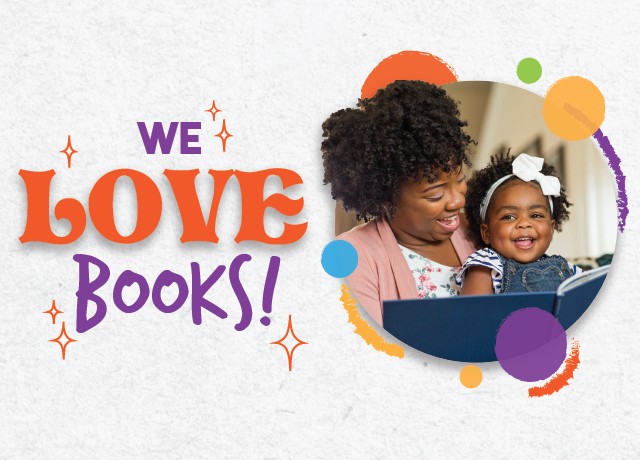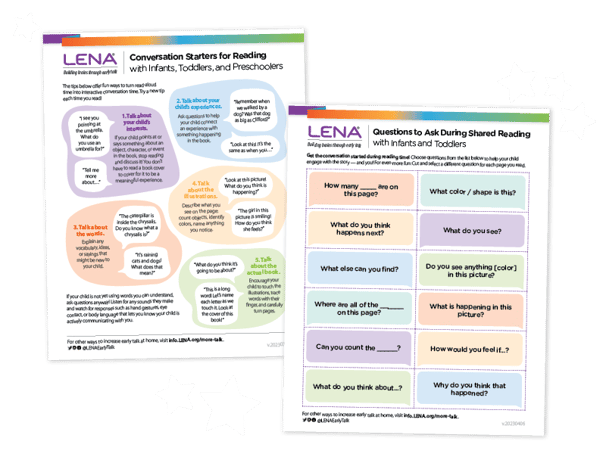If you’re the parent of a young child — and even if you’re not — you likely know that children’s books come in all shapes and sizes. Some are board books, unaffected by teeth and tearing. Others have hidden flaps and different textures that delight kids to no end. Some are so tall they don’t fit on an average bookshelf. Others are so small it’s hard for grown-up fingers to turn the pages. Some even require batteries. Others, frankly, require patience — and that’s okay. These various types of books are vital to early literacy development. They engage children from their very first months.
Compared to books for any other age group, books for infants, toddlers, and preschoolers are unique. Children’s books are so much more than vehicles for stories. Even before you crack the cover and read the first page, they’re kind of conversation pieces in and of themselves. For children, they’re invitations to rev the brain and ignite its neurons!
The adult-to-child and child-to-adult exchanges that books encourage — conversational turns — are totally unpredictable. Which is a good thing! Those conversational turns aren’t confined to the words on the page or the illustration on the cover. An adult’s imagination make conversations during read aloud time unlimited. As does a child’s ever-growing and magical imagination as they follow along!
We think this is a big part of what makes books special. After all, we’re an organization dedicated to showing that increasing positive adult-child interactions is the easiest way to supercharge children’s brain development, support early literacy skills, and improve their kindergarten readiness.
Reading Aloud For Early Literacy
You might’ve heard this saying before: “You can’t step into the same river twice.” It may very well be impossible to read the same book twice. Especially when your audience is an engaged, curious child or an infant whose brain is a blank slate. Anyone who has ever been made to linger on a single page of “Goodnight Moon” for five minutes, or has been made to engineer an off-the-cuff, elaborate backstory to Peter Rabbit’s mischievous ways, knows this to be true. The words on the page should make up just a part of the back and forth conversations you and the child experience. Even if the child isn’t talking yet.
Reading aloud is one of the most powerful activities for early childhood development. It creates rich opportunities for language interaction. In early childhood education settings and at home, these shared reading experiences build important foundations for lifelong learning.
Download our Resources for Shared Reading!
Get the conversation started during shared reading time! Both of these resources (Questions to Ask During Shared Reading, Conversation Starters for Reading) help support meaningful conversations with infant, toddler, or preschool children using any book, and are available in English and Spanish. Share with educators and families in your community!
5 Conversation-Boosting Reading Tips
Staying engaged and animated when you’re reading to very young children might seem intuitive to some, but it’s not always easy. Here are five tips for turning read-aloud time into interactive conversation time with the infants and toddlers in your life. Because one thing our research tells us is that most adults tend to overestimate how much they talk with children. Is it possible we overestimate how effectively we turn books into conversations as well?
1. Connect the book’s subject matter to something you’ve experienced together within the last day or two.
If you’re reading “Clifford the Big Red Dog,” ask the child whether they remember the dog they saw on the street earlier.
“Was it as big as Clifford?” “It wasn’t red like Clifford, was it?” “It looked like a really friendly dog to me.” “Do you think the dog sleeps outside in a doghouse like Clifford does, or do you think it sleeps inside?”
2. Follow the child’s lead, even when it takes you off on a tangent.
If you’re reading “Last Stop on Market Street” and your child points at or says something about Nana’s umbrella at the bus stop, pause and ask them what they like about the umbrella.
“People use umbrellas when it rains, don’t they?” “I like to carry an umbrella so I don’t get wet.” “When was the last time you saw someone using an umbrella?”
Nana’s umbrella is not all that important to the story. But it can be important to a child’s experience of the book.
3. Talk about the illustrations.
They say a picture is worth a thousand words. While you don’t have to use that many words to describe each picture, it’s certainly possible to use even more! In fact, the possibilities are infinite. Talk about the colors you see. Count the number of a certain object on a page. Or simply describe the scene, and wonder aloud whether or not the illustrator used a computer to draw the picture. These are all great ways to keep the conversation going.
4. Talk about the words, too.
Even for an infant, point out different elements like long words or squiggly question marks. Questions like, “They are funny-looking symbols, aren’t they?” can spark conversational turns. Fonts, font sizes, and font colors are all likely to change from one book to the next — or even from one page to the next! Talk about those too!
5. Don’t forget the book as a physical object with a history all its own.
“This book has a lot more pages than most books we read, doesn’t it?” “This book is heavy! I need to use both hands to hold it!” “Uh oh, one of the pages in this book has a little tear. I wonder how that happened!” “You and Daddy got this book together from the library the other day, right?” “This book used to belong to your cousin Rebekah.” “Grandma used to read this book to me, you know. I’ve always loved it so much!”
Want to learn more about how interactive reading supports early literacy in early childhood education? Explore LENA’s resources for parents and educators at lena.org/resources or sign up for our newsletter to receive tips and research on boosting children’s language environments.







3 Comments on “How To Turn Children’s Books Into Early Literacy Tools”
An excellent article. Great food for thought!!!
This is a great article. I’d love to share with with my young families at the library. Do you have a printable version, or would you mind if I printed it out to share?
We don’t have a printable version designed, but please do print it out and share widely!